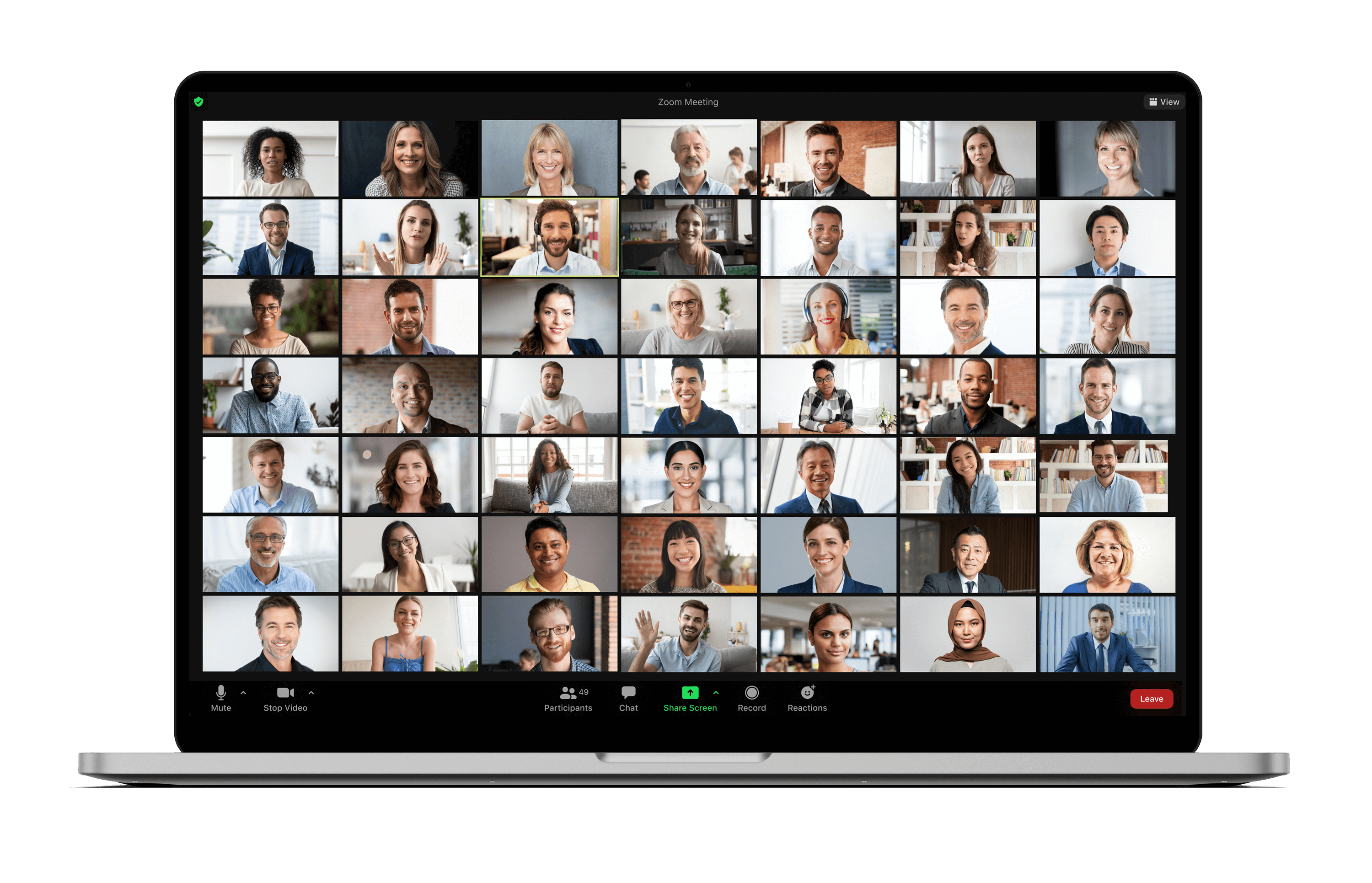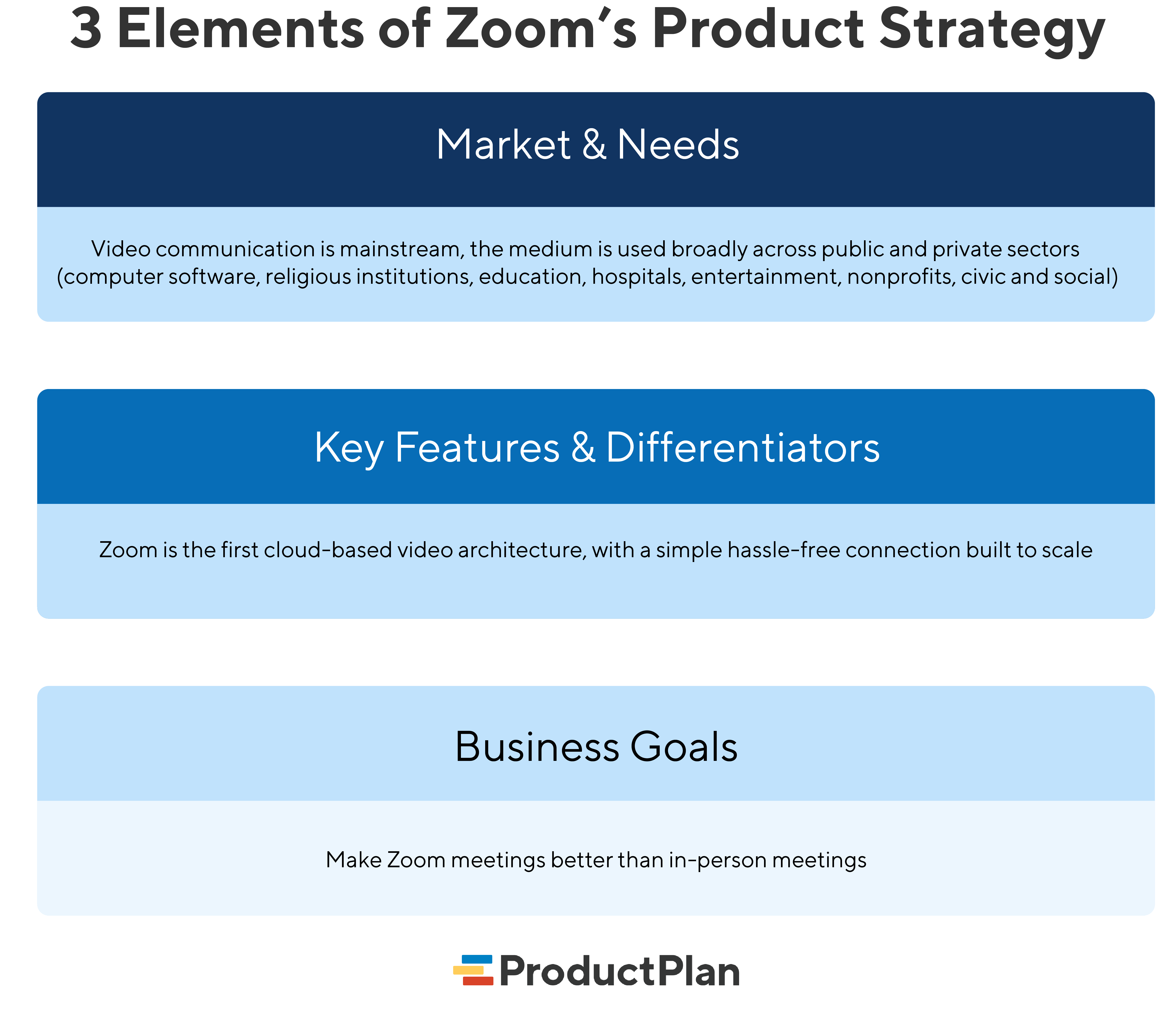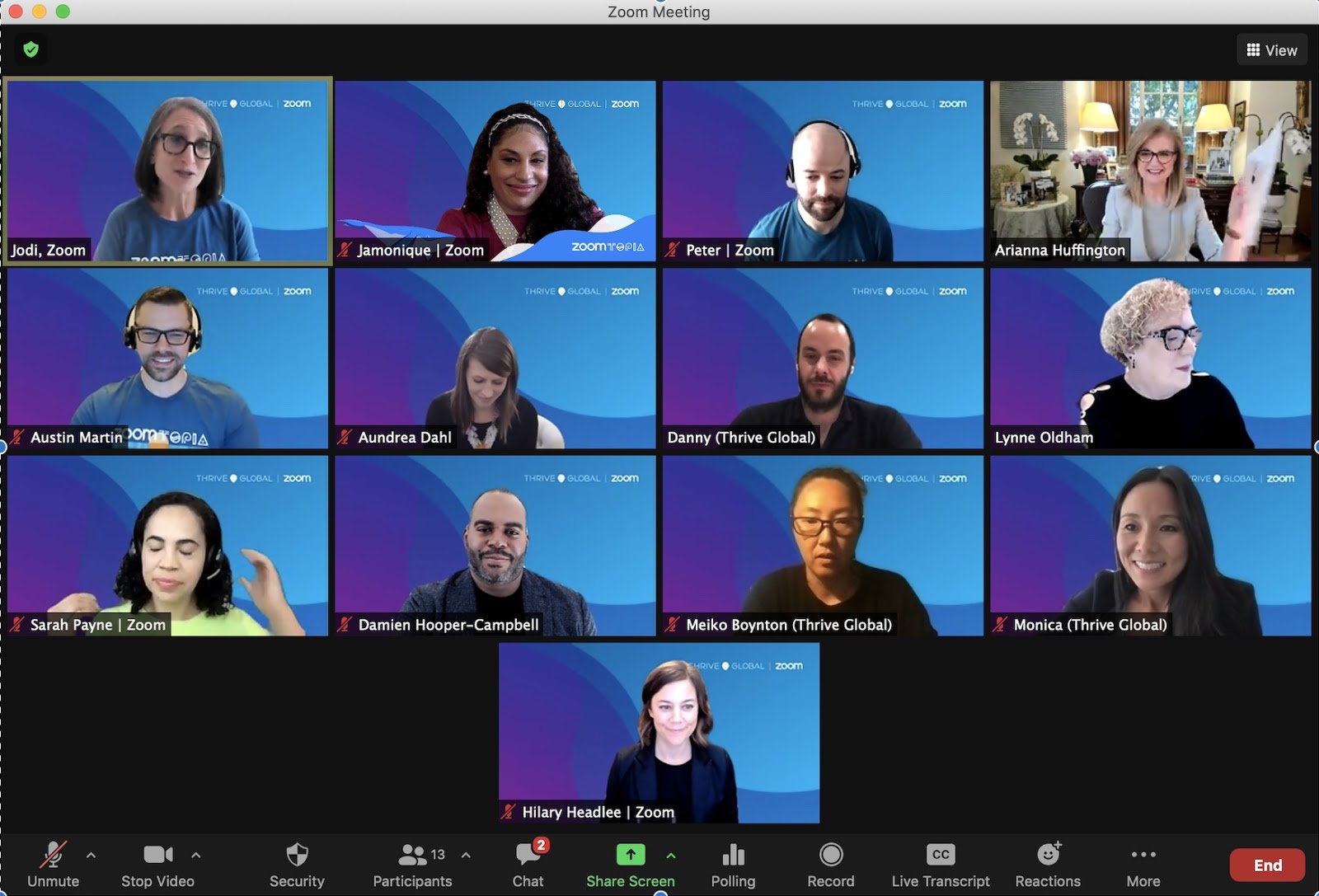A product strategy example focused on analyzing how Zoom’s product strategy scaled to meet the tsunami-swell connection demands an unexpected, unprecedented influx of users during a worldwide pandemic.
“Do you want to Zoom?”
Unless you live under a rock, you’ve experienced a video conference or two thousand in the last year— either as a participant or presenter. This experience is one of the many shared takeaways from a worldwide pandemic.
Zoom – as you are likely well aware – is a leader in video conferencing, joining the ranks of Google by transforming into a verb. A common refrain heard in households across the nation today is “Do you want to Zoom?”
Zoom for everyone
Zoom has become a language unto itself. Over the long months spent isolating, kindergarteners have grown as fluent in video conferencing as the ABCs. They are adorably reminding each other to mute or unmute during morning meetings. Grandparents, too, can now speak confidently about meeting codes and breakout rooms. Workers distanced from the communal office’s familiar walls are likely so immersed in Zoom-speak that they’re dreaming in technicolor Zoom.
We’ve all collectively settled into this brave, new Zoom world, quite frankly out of necessity. But also out of enormous relief and gratitude that we have an easy, accessible option to connect to some semblance of life as we know it as we navigate these strange pandemic times.

A master class for product-led growth
We didn’t know it yet, but a global pandemic set the stage for Zoom’s product strategy to be a master class in the product-led growth (PLG) model, an approach in which prospects take an active role in looking for a solution and experience a product firsthand before committing.
After many months in flux, we’re finally making peace with our new Zoom reality. But early on, it was a lot to navigate. And yet, we plodded on. There were moments, sometimes whole days, when we didn’t know how we would go on. We did, and we are more resilient than we give ourselves (and each other) credit.
Each of us rolled out of bed each day – some of us opting for comfort wear, others adapting our wardrobes to feature Zoom shirts – and did our best despite the circumstances. Everyone fired up laptops and tablets. We tidied up the areas directly behind us — anything that the camera might catch that would paint a less-than-rosy picture of our pandemic lives and expose the dumpster fire that many of us watched our lives become. We settled in at remote workspaces fortified by coffee and homemade bread. And we Zoomed on a scale never before seen in the history of video conferencing.
Humans are hardwired to connect. Zoom is purpose-built to enable an easy connection. But how exactly did Zoom’s product strategy keep us all connected at the same time — seemingly without so much as breaking a sweat?
We set out to understand how Zoom scaled operations to accommodate unprecedented demand and get people to school, work, and just about every other activity of daily life virtually. Here’s what we learned.
Connecting People at the Heart of Zoom’s Product Strategy
While Zoom may be a household name (or verb) these days, less so might be the name behind the ubiquitous tech: Eric Yuan, Zoom’s founder and CEO. However, the company’s product strategy took root in Yuan’s early personal and professional experiences.
Before founding Zoom in 2011, Yuan, who emigrated from China in 1997, joined a small, fledgling WebEx Communications team that quickly expanded, went public, and was eventually acquired by Cisco in 2007. His journey continued at Cisco, where, as Corporate VP of Engineering, he was responsible for its collaboration software development. While at Cisco, Yuan began to observe a pattern of discontent revealed in conversations and meetings with WebEx customers who were unhappy with collaboration solutions at the time.
“Yuan felt for the first time that he couldn’t satisfy his customers…WebEx customers grew frustrated with the quality of the product. They wanted WebEx to work reliably and more intuitively. And above all else, they wanted the video to run seamlessly.”
(CNN Business: Everyone you know uses Zoom)
Unhappiness can be a strong motivator.
“I firmly believed I could develop a platform that would make customers happy,” Yuan said. And in 2011, he leaped to create a video communications tool that would, above all else, delight customers.
A love story
Like any good story, love was at the heart of Yuan’s brainchild:
“I first envisioned Zoom when I was a freshman in college in China and regularly took a ten-hour train ride to visit my girlfriend (who is now my wife). I detested those rides and used to imagine other ways I could visit my girlfriend without traveling — those daydreams eventually became the basis for Zoom.”
And like any good love story, there was a fair amount of risk-taking and perseverance involved to realize the dream. Yuan’s eight attempts to be granted a U.S. visa failed. (Thankfully, he tried a ninth time.) His early Zoom team fought hard to raise its first round of funding of three million dollars. (Today, in a single month, the company’s stock is skyrocketing — surging over 600% since the beginning of 2020.) And the team also wrestled with finding the right go-to-market strategy.
But the struggle has certainly paid off — and then some.
Zoom today
Zoom stats today show that the company has approximately 265,400 customers that have more than 10 employees. It claims more than 300 million daily meeting participants. It has more than 2,500 employees around the world. Yuan was named Glassdoor’s top CEO in 2018 and ranked number one on Business Insider’s list of 15 best CEOs of 2019. And as of a September 9, 2020, Financial Times report, the company is now worth $35 billion.
And as if the last year hasn’t been busy enough for the folks at Zoom, the company was recognized as one of the best solutions for product managers at the 2020 Product Award. It earned a distinction for tools that “help product managers build the next great innovation” for its ability to connect teams.
Zoom is now an undisputed leader. In fact, it’s the one to watch in a crowded space that includes some pretty big names in video conferencing: Cisco Webex Meetings, Google Meet, GoToMeeting, BlueJeans Meetings, and join.me.
Centering on customers and delivering its promise to provide a simple, hassle-free connection continues to set Zoom apart from the big-name competition. By building on its PLG model, many of its key features are available for free, which gets Zoom into the hands of millions of users connecting for work meetings, school instruction, yoga classes, and book clubs. At the same time, other premium features are available with a paid subscription.

Zoom’s rise to leadership
That’s an astounding rise to a leading role on the world’s stage. Roman Pilcher, the product management expert, suggests a product strategy should contain three key elements. First, the market for the product and the specific needs it will address. Secondly, the product’s key differentiators or unique selling proposition. Lastly, the company’s business goals for the product.
In part, Zoom’s product strategy was born out of Yuan’s first-hand knowledge of WebEx’s unhappy users. In the Entrepreneur’s Handbook, Louise Morris notes, “Yuan didn’t come up with Zoom because he wasn’t allowed to fix WebEx—Zoom was an idea that was already there but improved over time. By identifying the weaknesses of future competitors, he built on his idea to have an advantage. He found potential in other people’s problems.”
According to Yuan, Zoom was purpose-built to accommodate many users. He explains:
“The goal was simple, a better service bringing happiness back to customers who want next generation communication, meaning they want to have better video collaboration experts. When I started, we already knew that video is the new voice and video communication will become a mainstream service in the future. That is why we made sure that our architecture is right. It was the first cloud-based video architecture in the world. We wanted to make sure that we can scale our business to have a customer base of millions, to be able to leverage the public cloud like Amazon, Oracle Cloud.”
Simple, hassle-free connection (in Zoom-speak: “frictionless communication”) has always been at the heart of this product story. From the get-go, Yuan and his team focused on what mattered most: Building a really great product that would easily bring people together – lots of people – while putting the needs of customers first.

A Business Built on Customer Delight
Zoom’s underlying mission is to make video communications frictionless and keep an unwavering eye on bringing joy to customers—the company’s product mission: To make Zoom meetings better than in-person meetings. From day one, customers have been front and center in developing the Zoom platform.
According to Yuan, “to have the best experience, you’ve got to take a different approach. You need to take a step back to really understand the customer’s problem and then invest your engineer time into the product.” He adds that simplicity is key for driving customer usage: “You make sure it’s effortless to use. If it’s too hard, nobody is going to use it.”
Delighting customers starts with happy employees. “We’ve got to make sure we love the solution. If employees aren’t happy, they can’t deliver happiness to our customers. Our culture is to deliver happiness to each other and deliver happiness to our customers.”
A fundamental focus on customers
Bringing goodness to the world has been a fundamental focus for the company. Zoom’s company culture famously “centers on happiness and caring,” said Yuan. “We expect our employees to care about the community, the company, their teammates, customers, and themselves.” This caring philosophy is a “common refrain in our all-hands meetings, and it is the core of the work at Zoom.”
Adds Nick Chong, Head of Global Support & Services at Zoom: “We have a relentless focus on making the best product with the best user experience. This is ultimately what every customer wants. Toward this end, we spend much of our time listening to customers and fine-tuning our software to fit their needs.” It’s worth noting that Chong’s company bio highlights his extensive expertise in technology, market development, product strategy, and pursuit of customer satisfaction.
Zoomtopia event showcases users
Even Zoomtopia, an annual Zoom-sponsored event that hosts keynotes, discussions, and sessions from Zoom’s partners, reinforces an unwavering focus on customers by highlighting product use cases. “Zoom actively asks its users to participate and share their stories for this event. Use cases act as social proof and help in reducing the resistance to adoption.”
OK, so customer satisfaction is the bedrock of Zoom. But what happens when customers exponentially multiply overnight due to a worldwide pandemic?

Global Pandemic Creates a Surge in Users and Forces a Change in Zoom’s Product Strategy
Quite suddenly, entire classrooms of students, schools, school districts had to pivot to distance learning. Students – from kindergarteners to college seniors – went remote. Teachers scrambled to transform in-person curriculum and strategies into a completely different format.
Similarly, an army of workers with varying experience working outside traditional office spaces scrambled to set up shop in the most unexpected places: closets, kitchens, a quadrant of the dining room table, basements. Before the dust could even settle, they had to carry on professionally as if nothing unusual were at hand. (Cue the kindergartener melting down in the adjacent quadrant of the dining room table and the dog barking in the background.)
Other activities began to shift online – things like healthcare consultations, music lessons, art classes, book clubs – even concerts and conferences went virtual.
Virtual meetings were no longer just for casual, occasional use. They were now a lifeline to school, work, and everything in the outside world.

Pandemic usage surge
To say that usage went up for Zoom is a gross understatement. From March 2020 to April 2020, daily meeting participants jumped from 200+ million to 300+ million in a single month. Compare that figure to the approximately 10 million daily participants just a few months prior in December 2019.
Of course, rapid growth often begets growing pains. Zoom room bombings entered the scene almost as shockingly as the pandemic, making already seriously stressed parents and teachers wary of turning their young students over to the potential dangers lurking in online classrooms.
Soon Zoom fatigue and burnout took hold. Everyone stretched thin trying to manage school meetings, work meetings, online appointments, virtual guitar lessons — the list seemed endless.
Then there was the creeping erosion of personal privacy in our own homes. Video calls making us feel vulnerable in the intimate spaces in which we were now indefinitely confined. And who can forget the rare instances of what should have remained truly private that was now broadcast on the world’s stage. To be sure, this army of fresh remote-work recruits had to train on how to behave in online meetings.
Acing the Ultimate Product Test
Even in the face of public scrutiny over security vulnerabilities, Yuan and his team kept listening to customers and taking action. They wanted to improve the product in ways that best serve users. Critics like tech journalist David “Doc” Searls and Citizen Lab research scientist Bill Marczak took note of Zoom’s responsive steps to criticism. Yuan viewed the scrutiny as an opportunity “to improve his company in ways that he could never have imagined otherwise.”
That being said, the surge in user demand and the ever-constant use shifted the roadmap on Zoom. Despite the pandemic (and staggering increase in usage), customers still expected unwavering reliability and access and a seamless, hiccup-free experience.
“While figuring out how to make scalable video calls was a daunting challenge, for Yuan’s Zoom team, it was only half the battle. They also had to make Zoom frictionless enough that anyone could use it. So easy that it makes his customers happy.”
(CNN Business: Everyone you know uses Zoom)
To leverage the special status carefully, Zoom needed to be easy to use. Grandparents depended on it to connect with distant families. Kindergarteners depended on it to connect with teachers and peers. People of all technical abilities needed to use it for all flavors of everyday life. Teachers and other professionals needed to be instant experts in guiding novice users and larger groups. No matter how large the user base grew, Zoom still needed to ensure streaming wouldn’t be affected by schools’ unprecedented heavy usage and remote workers.
Changing Positioning
It was immediately clear that Zoom needed to adjust its self-image. It had long positioned itself as a free business-to-consumer service. But now, the surge of heavy business usage called for a business-to-business model, too.
This was the ultimate test. It required a fast-tracking maturity across all elements of the product. In areas that Zoom, as an established B-to-C company, might have relaxed its focus in the past (business-grade security, for example).
Just imagine the conversations around the product roadmap back in March 2020. Zoom’s product team had to develop brand-new use cases that included many types of users. The users include grandparents with vision impairment, teachers who needed to facilitate discussions and engagement with remote students, and thousands of workers conducting confidential meetings from home computers.
Download The Product Roadmap Strategy Playbook ➜
Feature updates and enhancements like updated font sizes, breakout rooms, and, most important, tougher security were prioritized. These features rolled out quickly, which highlighted and demonstrated Zoom’s ability to empathize with its users, solve users’ problems, and delight them — all while navigating a pandemic with the rest of the world.
More changes were afoot on the product team itself. A good portion — by some reports, most — of Zoom’s product development team is based in China, where the company has more than 700 employees. Towards the end of May 2020, Zoom announced that Velchamy Sankarlingam joined Zoom as President of Product and Engineering. Reporting directly to Yuan, Sankarlingam was brought on to oversee Zoom’s product, engineering, and dev ops teams. Around that time, the company also grew its engineering team by around 500 employees on the U.S. side.
Zoom Was Scaling for Growth, Externally and Internally
However, it’s important to note that the company’s astonishing success isn’t solely the result of a pandemic crisis driving users online. Zoom was already chugging along on an impressive growth trajectory, gaining traction and rivaling the giants in the video conferencing space well before the pandemic. Its reputation of being reliable, less glitchy, less flashy, easier to launch, and more intuitive made it a standout when the pandemic took hold.
“Anyone concerned that Zoom will simply fade away once we’re over the COVID-19 crisis isn’t paying attention. Video meetings, virtual learning, and social Zoom gatherings aren’t going away entirely anytime soon. Zoom was never a pandemic growth story. For 10 consecutive quarters, customers with at least 10 employees have registered a trailing-12-month net dollar expansion rate of 130% or higher (that is, returning customers spent at least 30% more than a year earlier). The pandemic helped accelerate the revolution, but it was happening with or without the COVID-19 calamity.”
(The Motley Fool: 3 Reasons Zoom Stock Should Bounce Back)
Zoom’s product vision has always been simple: Connect people easily. As the company continues to navigate the pandemic and prepare for a post-COVID world, it’s not planning to differentiate user categories heavily. “I do not think we need to have a specific consumer strategy,” said Yuan. “No matter where you are, no matter what you do, no matter which device, we just help you to stay connected.”
Post-Pandemic Expectations
When the stakes are high and the stress unbelievably great. Yuan himself admits that April 2020 found him engaged in only three activities: Zoom, eating, and sleeping, though sometimes going without the latter for a few days. Yet when the entire world is watching you – that’s when you double down. If you can stay true to your mission and strategy in those conditions, you prove your mettle, and then some.
According to Yuan:
“From the moment we founded Zoom, our main focus has been to provide a cloud video communications solution that would make customers happy. That focus has continued to guide all our innovations, partnerships, and other initiatives. The fantastic growth we’re experiencing and the many industry accolades we’ve received can all be attributed to having satisfied customers that enjoy using our platform.”
But what happens after the pandemic? At some point in the future, students will return to physical schools again. Many remote workers – though not all – will return to brick-and-mortar office buildings. Will Zoom’s period of massive growth plateau? Will it plummet?
Zoom CFO Kelly Steckelberg doesn’t think so, asserting that remote work trends were already happening before the pandemic. “This has just accelerated it. Given the way that the world has embraced Zoom, we expect this experience of working from anywhere to continue in a post-COVID world.” Steckelberg adds, “We’re excited about Zoom’s ability to support workers as we transition back through capabilities like [Zoom Rooms] Smart Gallery, which enhances the experience of face-to-face communications between remote workers and those in the office.”
The future of work
Experts believe that the future of work post-pandemic will be more of a hybrid blend of remote work and occasional in-office time. Office time earmarked for special projects or necessary in-person collaboration (e.g., creating new products.) The Pew Research Center reports that: “Most workers who say their job responsibilities can mainly be done from home say that, before the pandemic, they rarely or never teleworked. Only one-in-five say they worked from home all or most of the time. Now, 71% of those workers are doing their job from home all or most of the time. And more than half say, given a choice, they would want to keep working from home even after the pandemic.”
Steckelberg adds that the company has also seen growth specifically in its customer base with fewer than 10 employees. This group has grown to 38% of Zoom’s revenue, up from 20% just one year ago (Q4 2019). “We’ve been inspired by the many creative ways we have seen our customers and prospects use Zoom during this pandemic,” continues Steckelberg.
Truth be told, however, Zoom was already used for a multitude of uses before the pandemic. From an interview in 2017, Yuan explained:
“Because it lets people meet face-to-face and provides support for screen sharing, it’s truly a collaboration catalyst and helps build teams across geographies. Zoom has a remarkably wide range of uses. In fact, Zoom is being used today by developers to write code together, by physicians to diagnose patients, by educators to conduct classes, lawyers to mediate or interview witnesses, and by actors to conduct virtual rehearsals.”
More than meetings
In its typical responsiveness to customers, Zoom recently launched OnZoom. OnZoom is an event-hosting platform to meet the needs of this growing group of small business owners and individuals. From the Zoom blog: “OnZoom is a comprehensive solution for paid Zoom users to create, host, and monetize events like fitness classes, concerts, stand-up or improv shows, and music lessons on the Zoom Meetings platform.”
The new platform makes it easy for SMBs and individual business owners to host and monetize virtual events. “That is something that is certainly going to continue after a vaccine because it’s just more convenient. You can take a piano lesson or cooking class from the comfort of your own home,” says Steckelberg. “It’s these innovations that are driving more interactions with our end-user customers.”
People First, No Matter What
In the end, Zoom’s product strategy has given us what the pandemic took from us: Connection to each other and what’s most important to us. During an unimaginable extended period of confinement and social distancing, Zoom helped us create new virtual pathways to meaningfully connect and maintain the most important aspects of our day-to-day routines. In doing so, it has established itself as a household name, recognizable by young and old alike — a silent enabler of and witness to our work, our play, and our relationships.
As the world changes
As the world transitions back to some semblance of normalcy, we think Zoom must continue listening closely to customers to successfully support the many ways that people will return to post-pandemic daily life. It will also need to actively reimagine its relevance in what will likely be an evolving new “norm.” And as we collectively try to forget the stress and trauma of our pandemic experiences, it’s crucial that Zoom carefully navigate what is already taking hold in casual conversations: the notion of Zoom fatigue. The world is weary of its months-long confinement. It needs a fall guy. Zoom needs to clarify that it wasn’t the problem–it was a key part of the solution.
We think Zoom will also need to leverage the special status carefully it’s earned during this collective crisis by finding ways to strengthen relationships forged during the pandemic and avoid becoming a triggering memory once the pandemic is history. This will be a critical component of the company’s long-term sustainability.
Customer conversions
Customer conversion will also be key for Zoom’s product strategy. The question is: Will it’s tested and proven record of keeping customers’ needs front and center at all times convert free users into paying customers?
Finally, what began as a panicked effort to keep working, learning, and connecting during a global pandemic has become a precious teachable moment: It is absolutely possible to keep working, learning, and connecting virtually with a simple, reliable tool like Zoom. If they haven’t already, companies of all stripes will reevaluate the need for costly business travel, which–in addition to lowering a company’s expenses–will have a significant impact on reducing carbon emissions and improving productivity.
For students and teachers in colder climes, this teachable moment might be received less enthusiastically. Online instruction and learning is effectively the death knell of the special snow day. Zoom has proven that both work and school (and just about every other imaginable engagement and human ritual under the sun) can carry on quite effectively in the cloud. Zoom should leverage this valuable learned experience and lead the charge in reducing the negative impact of unnecessary business travel. They can do this by simply staying true to Zoom’s product strategy: To make Zoom meetings better than in-person meetings (though it might want to add: So we can heal the planet).
Zoom’s Product Strategy Win
Building a great product and listening to customers every step of the way has been a winning product strategy for Zoom thus far. And when put to the test during a pandemic as usage skyrocketed beyond anyone’s wildest dreams, the company continued to listen, learn, and adjust.
If Zoom keeps listening, putting people first, and delighting users, we believe there’s no end to its potential growth and success. We honestly can’t wait to see what the next chapter holds for this people-first company in a post-pandemic world.


